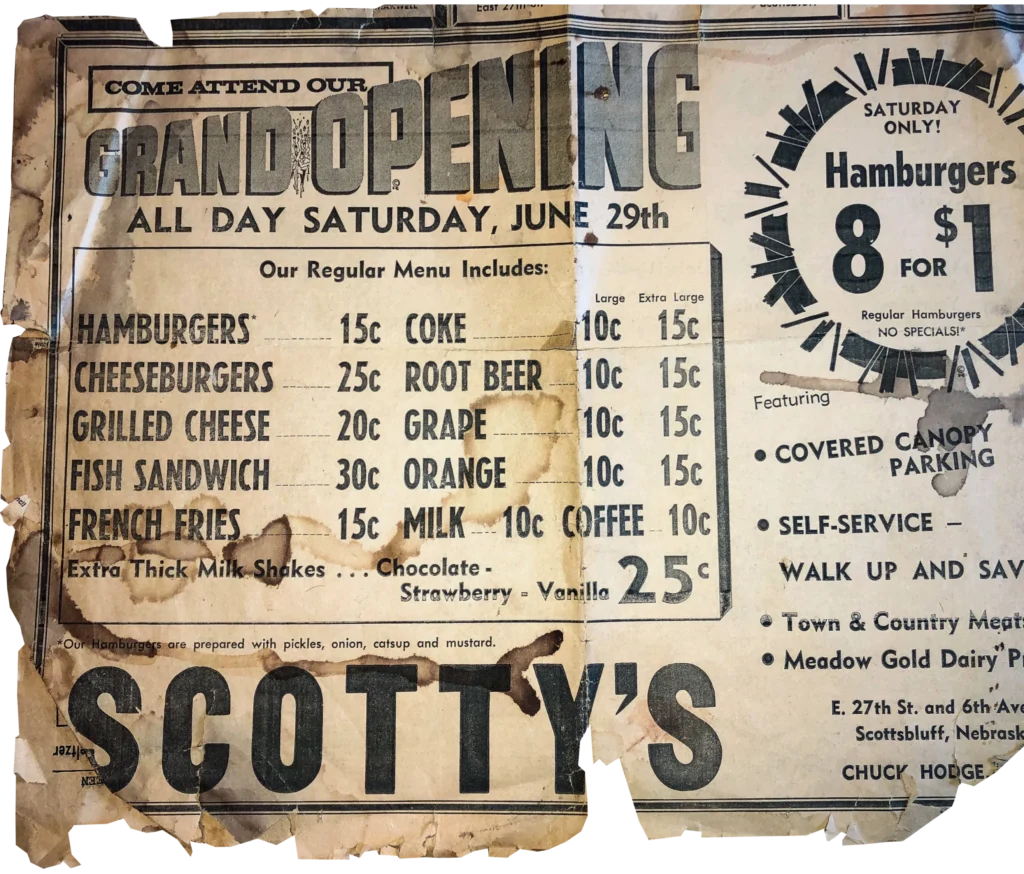| NEBRASKA |
Visitors to western Nebraska often find pieces of history while passing through the North Platte Valley to Jackson Hole, Sturgis, Rapid City, Deadwood, or some other destination. The immigrant trails, western Nebraska’s western heritage, agriculture, and rural culture hold particular interest to most visitors. Still, there’s always more to the Nebraska panhandle than meets the eye, and fast food hasn’t been excluded from its history.
Driving west on 27th Street from Highway 26, you’ll find remnants of the 1960s atop a small building that looks like it was plucked straight from The Jetsons cartoon. Brightly colored flying saucers adorn the roof and parking area, evoking the retro-futuristic style of Walt Disney’s 1960s EPCOT concept. These little saucers may lack the glamour or marketing muscle behind Disney’s futurist vision, but for those seeking a taste of a bygone era, this spot offers a unique culinary experience in western Nebraska.
What most people don’t realize is that before the Cola Wars of the late ’70s and early ’80s—when Coca-Cola and PepsiCo flooded the airwaves with taste tests and brand warfare—there was already a battle brewing for fast food dominance in the North Platte Valley. Long before Ronald McDonald or The King captured America’s attention, a power struggle for fast food loyalty was quietly underway. It began with the arrival of that little restaurant with the flying saucers in Scottsbluff.
| PRELUDE TO WAR
In 1963, Scottsbluff resident O. Charles “Chuck” Hodge was exploring investment opportunities in the North Platte River Valley when a friend suggested he look into a new and promising food chain called Scotty’s Drive-In. Known locally as “Scotty’s” in Scottsbluff, the franchise had modest beginnings in the early 1960s, with 17 locations opening across the Midwest. By 1966, Scotty’s had expanded into several regional markets, including North Dakota, South Dakota, Montana, Idaho, and Nebraska.
Hodge believed that opening a Scotty’s Drive-In franchise in Scottsbluff held strong potential, especially at a time when larger chains like McDonald’s and Burger King were just beginning to gain a foothold in smaller markets. Seeing the opportunity, he moved quickly to bring Scotty’s to town. The grand opening was announced in the local newspaper, and on June 29, 1963, Scotty’s Drive-In officially opened for business. It has remained a local fixture in Scottsbluff ever since. The restaurant met with immediate success, as there was only one other fast-food burger joint in the area at the time.
That competitor was Tom & Jerry’s, a fast-food restaurant located in nearby Gering, Nebraska. Before Scotty’s arrived, Tom & Jerry’s had built a near cult-like following as the sole burger joint in the region. This strong local support was encouraging for Hodge, who hoped to inspire similar loyalty. It wasn’t long before a healthy rivalry developed between the two establishments, with valley residents passionately debating who served the best burger in the North Platte Valley.
After six years of successful business, Hodge had saved enough to retire—no small feat considering he did it selling 19-cent hamburger meals. When the time came, he offered the restaurant to the highest bidder.
In 1969, Hodge sold the establishment to Mike Merkel, who had worked for years as his bread delivery man. Merkel had watched the restaurant’s rise and knew firsthand how much bread Hodge was buying—enough to realize there had to be real profit behind those burgers. After running the numbers, Merkel saw the potential. On any given day, up to thirty vehicles were parked and placing orders per hour. Seeing a solid return, he bought the business from Hodge.
Not long after taking over, Merkel had an idea: expand the menu. He added a new item to the fifteen already well-loved staples—and that’s when the burger hit the fan.
| TO THE VICTOR, THE SPOILS OF WAR
Much to the chagrin of both Hodge and Merkel, Tom & Jerry’s had long featured a sloppy-joe-style sandwich called the Tastey—their top-selling item and Scotty’s main competition. The Tastey was a beloved sandwich that many from that generation still reminisce about today. Its creator, Richard “Dicky” Ross, owner of Tom & Jerry’s, was notoriously protective of the recipe—keeping it locked in a safe inside the restaurant and allowing access only to trusted employees.
Then, one day, seemingly out of the blue, a new item appeared on Scotty’s menu. Merkel had taken the name Tastey—which had been trademarked—rearranged the letters slightly, and added a twist. He called it the Tastee Tavern. The sandwich hit the menu, and customers instantly fell in love with it.
Yes, we know—Tastee Tavern sounds like the name of a Cheyenne stripper-dive bar, but it’s not. The Tavern is a South Dakota–style sloppy joe, typically made without sauce. It’s also known in some parts of the Dakotas as a Maid-Rite—but we’re not going to touch that one. While it never became a staple food item in western Nebraska, the Tavern sandwich remains a familiar bar-style entrée across South Dakota to this day.
When Ross learned that Merkel had added the Tastee Tavern to his menu, he did a little digging. He discovered the Tastee Tavern was nearly identical to his trademarked Tastey, and privately accused Merkel of stealing his recipe. However, no evidence could be produced to substantiate the claim. Unfortunately, facts didn’t stop loyal customers from openly accusing Scotty’s Drive-In and Merkel of corporate espionage.
After a few more years of Scottsbluff and Gering residents passionately defending their favorite burger on both sides of the culinary rivalry—like a bad episode of Hell’s Kitchen—Tom & Jerry’s eventually conceded defeat in the North Platte Valley Burger War. Soon after, they closed their doors, abandoning their trademarked sandwich to the slang-shortened version of the Tastee Tavern, simply known as the Tastee among locals. That sandwich would go on to single-handedly fulfill its role as a legend in western Nebraska—where it still reigns, is still ordered, and is still eaten and enjoyed to this day.
| CONTINUATION
When Merkel came up with the Tastee Tavern, we doubt he could have foreseen the impact the sandwich’s history would have—becoming a throwback to the heady days of burger rivalry between Tom & Jerry’s and Scotty’s Drive-In. So the next time you visit Scotty’s and order one, give a little nod to the North Platte Valley Burger War, and to the victims it took to the gastronomic grave. They all fought a diligent and honorable battle, right up to the end.

Scotty’s Drive-In is a remnant of the past that still draws customers to its classic menu. It’s a local institution that shouldn’t be missed when visiting western Nebraska. Small, well-known, and almost religiously venerated, it has become one of the region’s most cherished fast-food landmarks. For those returning to the North Platte Valley, Scotty’s is often one of the first stops—a place tied to memory, tradition, and comfort.
There’s nothing else like it in western Nebraska. In fact, we can’t find another Scotty’s Drive-In anywhere in the state. The history—and the memories of malts, burgers, and shakes—still entices locals and visitors alike. So if you’re craving something truly tasty while traveling through the valley, consider stopping at Scotty’s. It’s not just food—it’s a slice of Nebraska history, served on a bun.
Scotty’s Drive-In
618 E 27th St,
Scottsbluff, NE
69361
Phone: (308) 635-3314
Facebook Page
CREDITS:
Alan & Mary Kay Haun – Previous owners of Scotty’s Drive-In Scottsbluff, NE
Special thanks to everyone who helped us on Facebook!
Story and Photography by: Hawk Buckman & Long Draw Studio


























